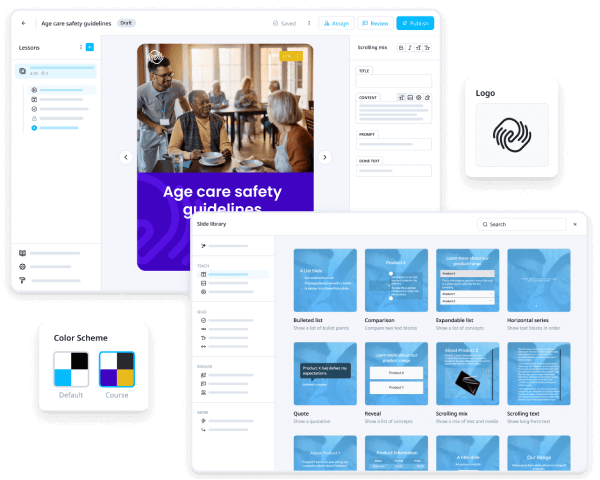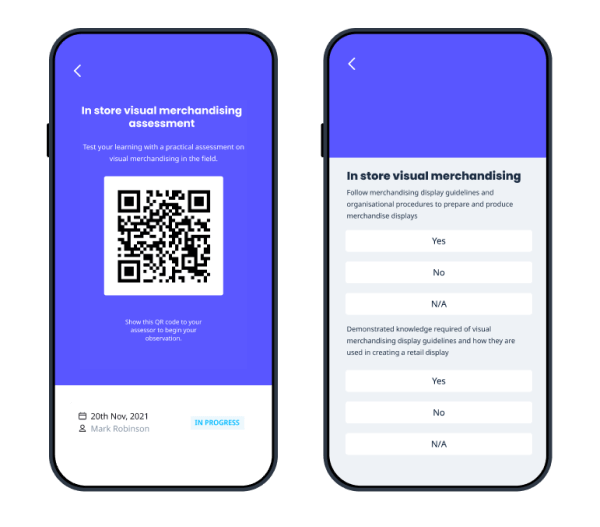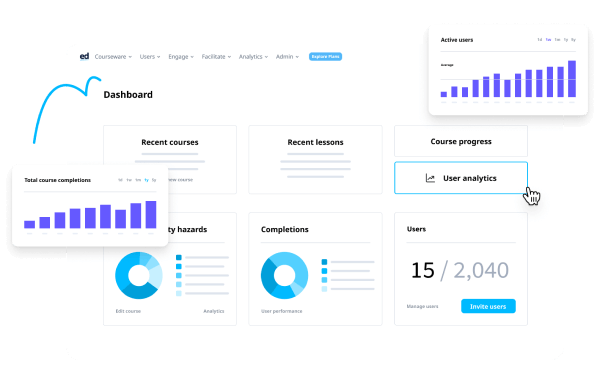How to create an effective Performance Improvement Plan (PIP)

Every employee has their own unique performance journey. While some consistently achieve exceptional results, others face temporary setbacks or challenges along the way.
If you’ve observed that an employee’s performance is not meeting the expected standards, the next step is to begin a performance improvement plan (PIP). This plan serves as a valuable tool to support their growth and development within your company.
In this article, we’ll explore practical tips for creating a performance improvement plan that works. We’ll also discuss the definition, importance, and parts of a PIP, as well as how to use a learning management system (LMS) to improve your team’s performance.
What is a performance improvement plan (PIP)?
A performance improvement plan is a tool you use to help employees who aren’t meeting performance expectations. Think of it as a roadmap for their improvement journey.

Here, you schedule a meeting with them to discuss your concerns and clearly communicate the areas they need to improve on. You can use this opportunity to set specific career goals and expectations for your employees to work toward.
The length of a PIP is typically defined in a few weeks or months, depending on the situation and certain factors, like:
- The complexity of the performance issues
- Employee’s willingness and ability to improve
- Clarity of expectations and goals
- Frequency of feedback and monitoring
- Availability of resources and support
Sign up with SC Training (formerly EdApp) today and give your team the resources they need to boost their performance.
Why is a performance improvement plan important?
Here are some of the reasons implementing a PIP is essential:
- A PIP allows you to actively support your employees’ growth.
Identifying performance gaps and creating a structured plan shows that you’re committed to helping them succeed.
- It enhances communication between you and your employees.
A PIP paves the way for much-needed discussions that can strengthen your working relationship and raise a culture of openness and collaboration at work. You can give constructive feedback to help them understand where they stand and what steps they can take to improve.
- It helps set clear expectations for your employees.
Outlining specific goals and areas for improvement means that you’re able to give your employees a clear path to success. This clarity allows them to focus their efforts and align their performance with organizational objectives.
- It paves the way for targeted development.
A PIP lets you identify the areas where your employees need to develop their skills or knowledge. You can take advantage of this to tailor development opportunities, such as targeted training, resources, or mentoring.
- A well-documented PIP can protect your organization from legal risks.
You can prevent potential legal risks connected with performance management issues by keeping records of performance concerns, improvement initiatives, and your employees’ responses.

What is included in a performance improvement plan?
A performance improvement plan typically includes the following elements:
- Reason for the PIP - why the plan is being put in place, identifying the need for improvement.
- Performance goals - clear objectives on what needs to be achieved.
- Areas of improvement and suggestions - specific aspects that need enhancement and recommendations on how to improve them.
- Metrics for evaluation - measures or criteria used to assess and gauge progress.
- Deadline for goals - a set date that indicates when the stated goals should be accomplished.
- Consequences for unmet goals - outlining what will happen if the goals aren’t reached.
Performance improvement plan example
Performance Improvement Plan (PIP) for Employee XYZ:
Reason for the PIP:
Employee XYZ has shown a need for improvement in meeting project deadlines and collaborating effectively within the team.
Performance Goals:
1. Complete assigned projects on or before the specified deadlines.
2. Enhance communication and teamwork skills to foster a more collaborative work environment.
Areas of Improvement and Suggestions:
1. Project management:
- Improve time management skills to secure timely completion of tasks.
- Use project management tools for better organization.
2. Communication and teamwork:
- Actively participate in team discussions and share ideas.
- Seek feedback and clarification when needed.
Metrics for Evaluation:
1. Project timelines:
- Projects completed within the set deadlines.
2. Team collaboration:
- Increased positive feedback from team members regarding collaboration.
Deadline for Goals:
Within the next three months, with a review scheduled at the end of each month.
Consequences if Goals are Not Met:
Failure to meet the outlined goals may result in a performance review and additional training opportunities. If improvement is insufficient, there may be further employment consequences. The aim is to guarantee continuous improvement and success within the team.
How to create a PIP
In some cases, employees may think of a performance improvement plan as a negative measure or a punishment rather than a supportive tool. That makes it extremely important that you know how to effectively craft one.
Here’s a detailed section that discusses how to create a PIP, along with tips and strategies for better outcomes.
1. Identify performance gaps
When writing a PIP, start by taking a close look at your employee’s performance and identify where they’re struggling. Doing this lets you effectively develop targeted plans to address them.

Follow these tips:
- Clearly define what success looks like in each role or task.
- Gain insights through observations, feedback, and performance metrics.
- Ask for input from managers, colleagues, and even the employees themselves.
- Review objective data such as productivity metrics, quality reports, or customer feedback to identify trends or patterns.
- Use formal evaluations to pinpoint your employee’s strengths and weaknesses.
- Benchmark against industry standards or high-performing employees to identify gaps.
- Focus on addressing high-impact gaps that significantly affect job performance.
2. Set clear and specific goals
Once you’re done determining the gaps in your employee’s performance, work with them to establish the goals that they need to achieve. Take note that the goals should fit the overall objectives of your team or company.
Follow these tips:
- Start with the big picture. Completely understand your organization’s objectives and priorities.
- Break down large goals into smaller and actionable tasks so it’s easier to execute them. What are the particular actions your employee needs to take to bridge those performance gaps?
- Make sure these goals are specific, measurable, achievable, relevant, and time-bound (SMART).
- Think about your employee’s capabilities, resources, and time constraints when coming up with objectives.
- Rely on a good performance improvement plan template online for easier implementation.
3. Set a realistic timeline
Be mindful of setting a realistic timeline for achieving the goals and milestones. That way, you don’t overwhelm your employee and instead give them enough time to grow.

Follow these tips:
- Assess how much improvement is needed and how difficult the tasks are.
- Take into account your employee’s current workload and availability when determining the timeline.
- Prioritize the most important tasks and arrange them in a logical order.
- Consider the time required for the employee to learn new skills or adapt to new processes.
4. Involve your employee in the process
Since your employee is the one working towards improvement, make sure they’re actively involved in the whole process. Having them take part in the discussions can boost their engagement, motivation, and sense of ownership.
Follow these tips:
- Encourage your employee to share their perspectives and suggestions about their own performance improvement.
- Prompt them to evaluate their performance and reflect on their own strengths and weaknesses.
- Listen actively and show genuine interest in their ideas, concerns, and feedback.
5. Offer relevant resources
Investing in tools and resources will go a long way. Offer the necessary resources to support your employee in their improvement efforts and help them learn the skills and knowledge to excel in their roles.

Follow these tips:
- Look for resources like workshops, effective training programs, online courses, or books that align with the identified areas of improvement.
- Include a variety of resources to accommodate different learning preferences.
- Choose the resources based on their unique requirements and learning styles.
- Tap into the expertise of experienced employees within your company who can offer them guidance or mentorship.
- Make sure your employee has access to the tools, software, or technology they’ll need.
6. Define the evaluation criteria
Determine how you’re going to evaluate your employee’s performance against the goals. Specifying the criteria and metrics allows for a clear and objective assessment of their progress.
Follow these tips:
- Identify the key performance indicators (KPIs) or metrics that align with those goals.
- Keep the evaluation criteria measurable and quantifiable.
- Establish clear benchmarks or standards against which performance will be assessed.
- Define the desired outcomes or results that indicate improved performance.
- Consider both qualitative and quantitative factors when defining evaluation criteria.
- Involve relevant stakeholders to gather input for a comprehensive evaluation process.
7. Schedule regular follow-up meetings
To create a supportive environment, plan regular check-in meetings. It’ll allow you to get a grasp of how they’re doing and make any necessary changes to the plan along the way. This also keeps your plan on track.

Follow these tips:
- Determine the frequency of follow-up meetings based on the needs and timeline of the PIP.
- Set a regular schedule for the meetings, such as weekly, bi-weekly, or monthly.
- Coordinate with your employee to find mutually convenient meeting times.
- Create an agenda for each meeting to give structure and focus.
- Allocate enough time for more discussions and feedback during the meetings. You can use the opportunity to review progress, discuss challenges, and offer feedback.
8. Keep a copy of your records
Put the PIP in writing and document the objectives, steps, timeline, and evaluation criteria. Doing so will serve as a reference for both you and your employee. Share the plan with them, have a conversation about it, and get their agreement and commitment.
Keeping organized and updated records of the PIP lets you track progress, demonstrate accountability, and have a reference for future evaluations or discussions.
Follow these tips:
- Create a folder or digital storage for your PIP documents and use clear file names to easily identify and find records.
- Save electronic copies of the plan itself, your goal-setting worksheets, and progress reports.
- Include any supporting documentation like performance evaluations, feedback forms, or training certificates.
- Keep track of important dates, including the start date of the plan, milestone deadlines, and completion dates.
- Maintain confidentiality and follow privacy policies and regulations.
9. Monitor and adjust the plan if needed
Throughout the whole process, it’s important to keep a close eye on your employee’s progress. That way, you can make sure that the PIP remains relevant and effective in supporting their development.

Follow these tips:
- Use PIP HR tools or performance management systems to monitor key performance indicators or metrics.
- Collect feedback from relevant stakeholders, such as supervisors or team members.
- Review the plan periodically to evaluate its effectiveness.
- Consider external factors or changes in circumstances that may impact the plan.
- Communicate the potential changes to your employee and make adjustments to the plan as needed.
- Acknowledge their progress and continue to support their ongoing development.
Remember: The purpose of a PIP is not to punish or intimidate your employees. Rather, approach it with empathy and a genuine desire to help your employee succeed.
Improve your employee’s performance with SC Training (formerly EdApp)
A good learning management system can be a great asset when it comes to taking your performance improvement plan to the next level. If you’re looking to enhance your initiatives, SC Training (formerly EdApp) is the way to go.
SC Training (formerly EdApp) is a user-friendly LMS that you can use to give your employees easy access to a wide range of learning resources. It has a virtual library of training materials, courses, and educational content covering topics across different industries.
Enhance your PIP through the following features:
- Course authoring tool
With SC Training (formerly EdApp)’s AI-powered creator tool, you can quickly create and assign training courses to employees who need improvement in certain areas. You can have targeted training and customize their learning experience to directly address the gaps you’ve identified in their PIP.

- Assessments
The platform comes with handy features like assessments and assignments that allow you to test your employee’s understanding of the training content. You can add quizzes in between lessons or a final assessment at the end of your course. SC Training (formerly EdApp)’s AI tools will let you generate related questions in just minutes.

- Course library
PIPs should be about more than just short-term improvements. They should encourage continuous growth. With SC Training (formerly EdApp)’s editable course library, you can easily offer a range of ongoing learning opportunities. You can quickly update these courses, while your team can access additional resources and explore new skills beyond the initial PIP.

You can also give them access to refresher training courses or advanced training to help them maintain and further develop their improved performance.
- Reports and analytics
You can track and monitor employee engagement, completion rates, assessment scores, and overall progress through reporting and analytics. This data helps you evaluate the effectiveness of the training and measure the impact on performance improvement.

- Flexible and self-paced learning
One of the coolest things about SC Training (formerly EdApp) is that it offers flexibility in terms of when and where your employees can access training materials. They can learn at their own pace and fit training into their busy schedules without disrupting their daily work routines.

Enhance your PIP with the best employee learning and development tool! Join SC Training (formerly EdApp) today.
Author
Ella Mar
Ella is a content writer for SC Training (formerly EdApp), an award-winning e-learning management system designed to help companies deliver high-quality workplace training. In her free time, she enjoys painting, reading, or playing with her cat.
